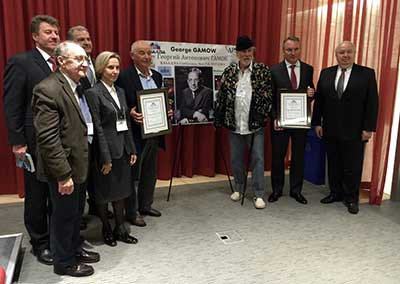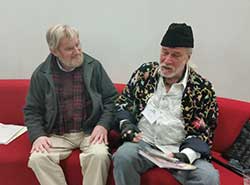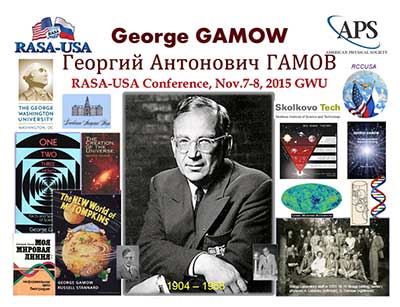George Gamow, Famous Russian-American Physicist, Honored by GWU, Scientific Diaspora and Diplomats in Washington
by Vladimir Shiltsev

2015 RASA Gamow Award ceremony (left to right): Prof. Vladimir Shiltsev (RASA President, Fermilab), Prof. Roald Sagdeev (UMD, physics), Dr. Nikolay Vasiliev (President RASA-USA, Harvard), Prof. Lyudmila Ogorodova (Deputy Minister of Education and Science of the Russian Federation), Prof. Vladimir Zelman (2015 Gamow Laureate, USC), Prof. Igor Gamow (Colorado), Prof. Igor Efimov (2015 Gamow Laureate, GWU), and Ambassador Sergey Kislyak.

George Gamow commemorating plaque on the GWU Physics Department's Corcoran Hall.
The author is Director of the Accelerator Physics Center at Fermilab.
George—or Georgy Antonovich in Russian—Gamow was an outstanding theoretical physicist. He was born in the Russian Empire in 1904, received his education in the Soviet Union, and became a corresponding member of the USSR Academy of Sciences as one of the brightest representatives of the “new generation” of physicists. Gamow spent several years among a brilliant assemblage of physicists of the in-between-the-wars Europe and after immigration to the US in 1934, established a new school of physics in the United States. His career in the US spans for more than three decades, including 22 years at the George Washington University (GWU) in Washington, DC, and 12 years at the University of Colorado, until his death in 1968. The list of Gamow accomplishments includes several “Nobel-caliber” works—the theory of radioactive decay and nuclear transformations, the Big Bang theory, nuclear fusion and cosmic microwave radiation, insights on the mechanism of the DNA double helix work, and others. But for general public of up to our days his name is widely recognized due to his brilliant popular books which influenced several generations of students, graduate students and people interested in science. Of particular recognition are a book series on a hypothetical Mr. Tompkins, a clerk trying to understand the science behind various phenomena, a stunning book “One, Two, Three ... Infinity” explaining “how things work” to laymen and his sci-pop articles in magazines and newspapers. George Gamow’s legacy has been commemorated by a plaque on the GWU Physics Department’s Corcoran hall, by Gamow’s Tower in the University of Colorado, in the book “Genes, Girls and Gamow after the Double Helix” by the Nobelist James Watson, in his biographies published by the National Academies and in the Physics in Perspective magazine.
George Gamow’s 111th birthday was recently celebrated at GWU by the Russian scientific diaspora during the 6th annual conference of Russian American Science Association (RASA), November 7-8, 2015. RASA is a nonprofit organization working to consolidate the Russian-speaking scientific community abroad, to advance the career development and qualifications of its members, and to provide opportunities for social and cultural exchanges. RASA represents about 300 members, including scientists, engineers and hi-tech entrepreneurs in academia, national laboratories and industry. It is part of an international Russian-speaking Academic Science Association, which also unites the European and Asian branches. The objectives of RASA include the exchange of knowledge and experience, initiation of joint projects, coordination of research programs, organization of conferences, seminars, research schools, sharing knowledge of teaching programs and lecture materials. More on RASA and its goals can be found in the December 2012 issue of “APS News” and in the Fall 2013 issue of the “APS FIP Newsletters”.
More than 160 scientists from the US and Russia attended the 2015 RASA conference which was sponsored by the “International Friends of APS Activity” grant. The APS sponsored a special session dedicated to George Gamow thus sending a strong message that RASA’s initiative is very meaningful to the American, the Russian-proper and the Russian scientific diaspora communities and that the event helps to form “diplomatic links” and to strengthen communication and collaboration among our physics communities. Right after the conference Emily Conover of APS published a very nice article “Russian-American Scientists Honor George Gamow (1904-1968): Conference session celebrates physicist born 111 years ago” in the APS News: and, later, the link to it (with George Gamow’s photo) made it to the front page of the APS main web-site.
Amy Flatten, APS Director for International Affairs, opened Gamow’s session with a short welcome message about how the United States will remember and appreciate the contribution of Gamow and with gratitude for organizing the memorial RASA Conference. Professor William Briscoe, Chair the GWU Physics Department, elaborated on the achievements of George Gamow—which he called the most outstanding scientist who has ever worked in the walls of his university—and on how GWU keeps up Gamow’s scientific heritage: from a memorial plaque on the Physics Department building, to the commemorative meetings and support of the Gamow’s studies, like, e.g., those conducted by Gamow’s major scholar Prof. Eamon Harper of GWU.

Prof. Igor Gamow, son of George Gamow (right), and Gamow's biographer Prof. Eamon Harper of GWU at the 2015 RASA-USA conference.

Conference poster of the 2015 RASA-USA "George Gamow" conference (November 7-8, 2015)
The most entertaining part of the session was a presentation of George Gamow’s son, Igor. Professor Igor Gamow, who flew to the conference from Colorado, gave a lively and interesting account of his father, showed several video clips about him and told a number of stories and anecdotes about George and his friends. The audience literally bombarded Igor with questions and did not want to let him go.
Scientific reports followed—first, Vladimir Shiltsev of the Fermi National Accelerator Laboratory (Batavia, IL) described several puzzling results of modern fundamental physics (from unexpected peaks in the data of the Large Hadron Collider, to the periodic variations of the measured gravitational constant, to the “Penrose rings” in measurements of cosmic microwave radiation of the universe as possible hints of previous reincarnations of the Universe before the Big Bang). Dr. Igor Moskalenko of Stanford University gave an overview of the modern astrophysics including recent studies of high-energy cosmic particles, the Sun, stars and galaxies.
The George Gamow session was the key scientific event of the 2015 RASA-USA conference. George Gamow’s life and works are fully consonant with the aims and activities of the association, and so it seemed natural that RASA-USA established the award named after Gamow which goes to scientists of the Russian diaspora who have made outstanding contributions to science and contributed to the strengthened international reputation of Russian science. The first-ever RASA-USA Gamow Award ceremony celebrated two recipients—Professor Igor Efimov, a 1986 graduate of the Moscow Physical and Technical Institute, currently a Chair of the GWU’s Department of Biomedical Engineering, for his work on the physics of the heart and contribution to the development of the Association (he was the first President of RASA-USA); and Professor Vladimir Zelman of the University of Southern California, a 1956 graduate of the Novosibirsk Medical Institute, for his contribution to the development of neurology and organization of medical research centers in Russia.
Ambassador of the Russian Federation to the US, Mr. Sergey Kislyak—himself a physicist, graduated from the Moscow Engineering Physics Institute—reminded the audience that at 28, George Gamow became the youngest member of the USSR Academy of Sciences, then—after his emigration—was excluded from the Academy, but then in 1990’s was restored in the modern day Russian Academy of Sciences. Ambassador Kislyak remarked that George Gamow is the clearest representative of what he called “thinking in Russian”—the motto of the RASA Association.
The George Gamow session at the 2015 RASA Conference has been a remarkable commemoration of the remarkable Russian-American scientist.
The articles in this issue represent the views of their authors and are not necessarily those of the Forum or APS.
